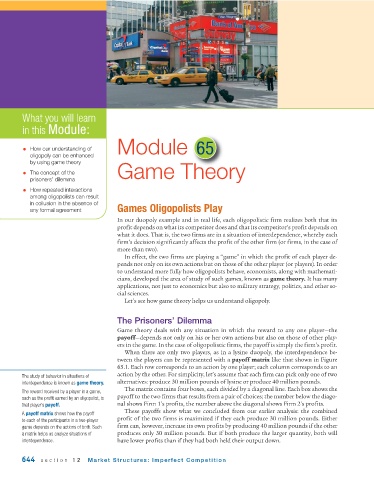Page 686 - Krugmans Economics for AP Text Book_Neat
P. 686
What you will learn
in this Module:
• How our understanding of Module 65
oligopoly can be enhanced
by using game theory
• The concept of the Game Theory
prisoners’ dilemma
• How repeated interactions
among oligopolists can result
in collusion in the absence of
any formal agreement Games Oligopolists Play
In our duopoly example and in real life, each oligopolistic firm realizes both that its
profit depends on what its competitor does and that its competitor’s profit depends on
what it does. That is, the two firms are in a situation of interdependence, whereby each
firm’s decision significantly affects the profit of the other firm (or firms, in the case of
more than two).
In effect, the two firms are playing a “game” in which the profit of each player de-
pends not only on its own actions but on those of the other player (or players). In order
to understand more fully how oligopolists behave, economists, along with mathemati-
cians, developed the area of study of such games, known as game theory. It has many
applications, not just to economics but also to military strategy, politics, and other so-
cial sciences.
Let’s see how game theory helps us understand oligopoly.
The Prisoners’ Dilemma
Game theory deals with any situation in which the reward to any one player—the
payoff—depends not only on his or her own actions but also on those of other play-
ers in the game. In the case of oligopolistic firms, the payoff is simply the firm’s profit.
When there are only two players, as in a lysine duopoly, the interdependence be-
tween the players can be represented with a payoff matrix like that shown in Figure
65.1. Each row corresponds to an action by one player; each column corresponds to an
action by the other. For simplicity, let’s assume that each firm can pick only one of two
The study of behavior in situations of
interdependence is known as game theory. alternatives: produce 30 million pounds of lysine or produce 40 million pounds.
The matrix contains four boxes, each divided by a diagonal line. Each box shows the
The reward received by a player in a game,
payoff to the two firms that results from a pair of choices; the number below the diago-
such as the profit earned by an oligopolist, is
that player’s payoff. nal shows Firm 1’s profits, the number above the diagonal shows Firm 2’s profits.
These payoffs show what we concluded from our earlier analysis: the combined
A payoff matrix shows how the payoff
profit of the two firms is maximized if they each produce 30 million pounds. Either
to each of the participants in a two-player
game depends on the actions of both. Such firm can, however, increase its own profits by producing 40 million pounds if the other
a matrix helps us analyze situations of produces only 30 million pounds. But if both produce the larger quantity, both will
interdependence. have lower profits than if they had both held their output down.
644 section 12 Market Structures: Imperfect Competition

